
Alarm systems are not just for intrusion protection anymore. By making contacts or motion detectors part of an integrated security system that also includes access control and video surveillance, systems integrators can ensure that security personnel are alerted when a door is used inappropriately or an area is violated. The alarm signal also can be used to automatically aim the camera at a violated area and automatically display video from that camera. And even when a client has its own security staff to monitor the integrated system, central station alarm monitoring can provide a helpful backup to on-site personnel. In this article, SDM profiles three installations that have benefited from making an alarm system part of a complete integrated security system.
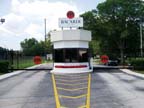
Bacardi Bottling Corporation, Jacksonville, Fla.
Before beverage manufacturer Bacardi Bottling Corporation completed an upgrade to the security system at its 100-acre Jacksonville, Fla. facilities this year, the alarm systems there were used primarily to alert round-the-clock security personnel to potential problems, which they would then have to go and investigate. In undertaking the upgrade, Bacardi’s supervisor of security operations, Paul Gallagher, CPP, notes the goal was to “provide a safer environment for employees and to enhance the security department’s response capabilities to alarm or emergency situations.â€
The upgrade entailed installing new access control and video surveillance systems, which were integrated with the existing alarm system. “If an alarm activates, we have an instant response on the computer screens in the monitoring station, and cameras in the area pan automatically to view the area where the alarm occurred,†Gallagher says. “It’s helped cut down on having to respond to things that are not security related. If an alarm comes up, the camera is pre-programmed to look at the area. We don’t have to waste time trying to analyze what happened. If the fire alarm goes off, we know whether to call the fire department.â€

Images from all of the video cameras in the system are recorded continuously. A RAID array is used for storage. “Since all of the cameras are recording all the time, this allows us to keep a large amount of video,†Gallagher explains. Because the new system is digital and is tied in with the alarm system, it’s relatively easy for security personnel to locate the appropriate images when reviewing stored images to investigate an incident. “You can go back almost instantaneously to find something,†Gallagher says.
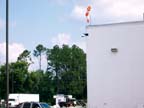
Because the system is interconnected through Bacardi’s computer network, authorized personnel, including certain company executives, can check the status of the system and view video images through other network-connected computers. “Human resources can use it to check if an employee is in or out,†Gallagher says.
“The security officers love it,†Gallagher adds. “It’s very easy to use and training was minimal. It just requires basic computer skills.â€
The integrated security system at Bacardi’s Jacksonville facility uses a Lenel Onguard 2005 access control system and Axis PTZ IP video cameras. The systems integrator was Security One of Jacksonville.
“The installation and commissioning of the state-of-the-art integrated security system at the Bacardi Bottling Plant was a great challenge and experience,†notes Mike Taylor, senior security advisor for Security One. “The planning, design and engineering for the security equipment, utilizing access control, exterior PTZ network cameras and the integration of the existing alarm system took a coordinated effort from all involved in the project. Bacardi, Lenel and Security One Systems accomplished the task by working together towards a common solution. The final result was a customer that has a leading-edge technology security system and one who is totally satisfied with the outcome.â€

Photo courtesy A&A Fire and Security
Northeast Wisconsin, Community Shelter, Green Bay, Wis.
When the Northeast Wisconsin Community Shelter in Green Bay, Wis., was condemned and a new shelter was built to replace it, administrators recognized an opportunity to enhance the level of security for homeless residents, staff and volunteers. They enlisted A&A Fire and Security Inc., also of Green Bay, to install an integrated alarm, video and access control system, which was completed earlier this year. The goal, explains A&A Fire and Security owner Tom Binish, was “to provide a safe environment for staff and to develop a means of auditing and tracking users of the facility.â€On a typical day, 75 to 100 homeless people use the shelter, but it can house as many as 200 people if needed. “Over the course of a year, as many as 1,500 will pass through,†Binish says. In addition, the shelter has 10 full-time staff people and about 30 volunteers. Regular users, including staff and homeless residents, are issued access cards. “Some [cards] time out after seven, 14 or 90 days,†Binish explains. “Some [cards] are given out permanently.†Cards can be re-used and residents pay a $15 deposit fee to help ensure the return of the cards.
The three-story shelter has separate floors for men and women, along with some common areas. The 14-reader system controls which users get access to each area. It also limits time of access. “If people are not in by 10:00 p.m., the card won’t work and they have to be let in,†Binish notes. That procedure helps staff and volunteers confirm that a resident is behaving in an appropriate manner before letting him or her into the shelter.
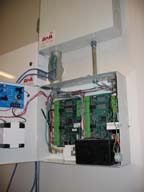
As backup, the system is also monitored by A&A’s central station. Central station operators do not receive video images, but they do receive the same alarm signals that the on-site staff person receives. “If an unauthorized person uses an exit door, we call the site and relay the information to a staff person on duty in the event that person got called away from his post,†Binish notes. The central station also monitors wireless duress buttons that can be activated by staff in the event that a resident becomes unruly.
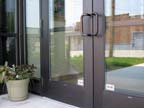
Photo courtesy A&A Fire and Security
Shelter administrators are pleased with the system and “are constantly thinking of new ways to use it,†he adds. At the client’s suggestion, a door annunciator was connected to the front desk to help verify that the door actually closes behind a resident who leaves the facility. That capability helps allay fears that a resident might let in people who don’t belong there.
For an added level of security, images from the video cameras are recorded continuously – a capability that benefits local police, who randomly review the video recordings in search of parole violators. “Future plans call for client software to be loaded at the police department so the police don’t have to travel to the site,†Binish notes.
The integrated security system at the Northeast Wisconsin Community Shelter is based on a NexWatch by Honeywell access control system integrated with a Honeywell Fusion video server.

Photo courtesy Eaton Corp.
Eaton Corporation, Galesburg, Mich.
Eaton Corporation’s 600-employee location in Galesburg, Mich. is a particularly critical one because it is the worldwide headquarters of the conglomerate’s research and development unit. “We have intellectual property and data to protect,†notes Scott Branstetter, environmental health and safety manager for Eaton Corp.
Until mid-2004, Eaton Corp.’s Galesburg facility was protected by a basic access control system that used a five-digit key code. The system was tied in with door contacts with the intent of monitoring doors so that they were not held open too long and to guard against forced entry. But that capability was not used to its full extent, in part because the system was not self-monitored. Instead, violation reports were sent to the facilities department in a remote location. The requirement for security personnel to go to the violated door to investigate also was problematic.
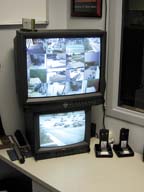
Photo courtesy Eaton Corp.
“It’s let our guards be much more effective,†Branstetter says. In the past, guards roamed the facility and it was “the luck of the draw†for them to happen upon security problems, he notes. “Now they have full control of the cameras and can see the entire property. Many of the cameras are pan-tilt-zoom, enabling them to focus where they want to see. They know so much more about our facility.†Branstetter also likes the fact that the system can be zoned so that only certain employees can access laboratories and other high-security areas.
“There’s accountability now,†Meuser adds. “They can identify the individual who caused a violation and can address it directly with the individual or with the individual’s superior.†For added security, images from the video cameras in Eaton’s Galesburg system are recorded continuously. These can be speedily reviewed in the event of an incident, such as when an employee’s vehicle is damaged while parked in the company’s lot.
Branstetter points out another benefit of the new system. “We have better visitor management now,†he says. Access cards from other Eaton Corp. locations will work on the Galesburg system, provided that an authorized administrator has activated them. “We have a 45-day use-it-or-lose-it feature,†Branstetter adds. If an employee goes 45 days without using the system, he or she is locked out and has to visit a security guard to reactivate his or her card. Galesburg security personnel also monitor Eaton’s semi-truck test track, located 60 miles away, over a T-1 line. The access control and alarm systems at the remote location are integrated with the Galesburg system.
Eaton plans to undertake the second phase of its security system upgrade shortly. That phase will include adding turnstiles and gated parking lot entry.
